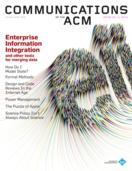ACM’s Place in the Global Picture
September 2008 - Vol. 51 No. 9

Features
Knuth’s Art of Recovering from Errors
Technology Strategy and Management: The Puzzle of Apple
Kode Vicious: Pride and Prejudice (The Vasa)
Navigating the well-traveled course of communication failure that often leads to engineering disasters.
IT Policy: Science Policy Isn’t Always About Science
Viewpoint: Global Warming Toward Open Educational Resources
How Do I Model State?: Let Me Count the Ways
CTO Storage Roundtable, Part Two
Software Engineering and Formal Methods
Beyond Keywords: Automated Question Answering on the Web
Design and Code Reviews in the Age of the Internet
Information Integration in the Enterprise
Technical Perspective: Transactional Memory in the Operating System
TxLinux and MetaTM: Transactional Memory and the Operating System
Technical Perspective: Distributing Your Data and Having It, Too
Distributed Selection: A Missing Piece of Data Aggregation
Puzzled: Solutions and Sources
Using and Fixing Biased Rating Schemes
Using Traceability to Mitigate Cognitive Biases in Software Development
Understanding User Perspectives on Biometric Technology
Following Linguistic Footprints: Automatic Deception Detection in Online Communication
Towards Agility in Design in Global Component-Based Development
The Student Productivity Paradox: Technology Mediated Learning in Schools
What Factors Drive the Assimilation of Internet Technologies in China?



